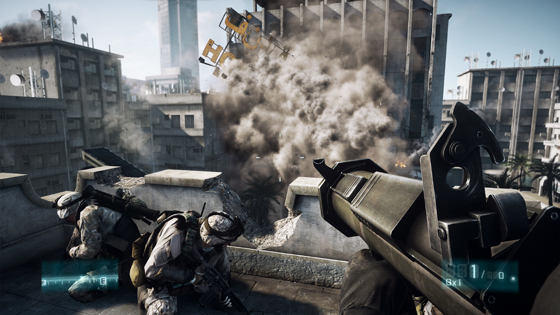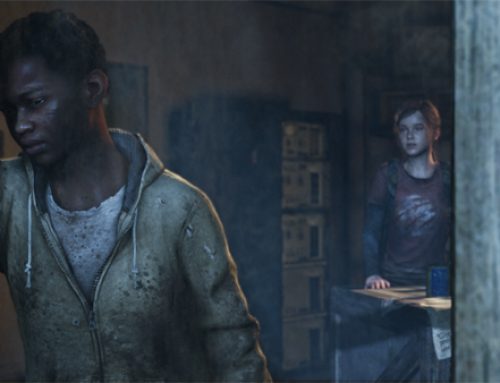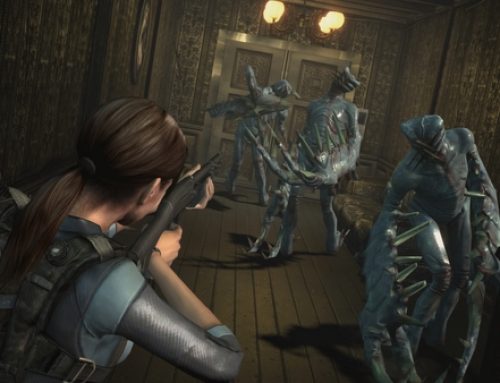
Taking down a sniper with a rocket launcher in Operation Swordbreaker felt like the gaming equivalent of a Dick Cheney quail hunt, in which your epic moment is carefully scripted by unseen forces.
Note: My column in Friday’s newspaper is about beta tests, specifically gamers’ reactions to the somewhat rocky beta for “Battlefield 3” and my own reaction to a chance to play the beta for upcoming PC game “Diablo III.” For the blog, I’m writing a little more on each game and splitting the column into two posts. This is the “Battlefield 3” post. A “Diablo III” post will be along later this weekend.
High-speed Internet and gaming’s growing popularity have propelled beta tests of upcoming video games beyond their original purpose of improving the product. These days, betas don’t just provide feedback for developers; they can be an important marketing tool. But just as a polished, fun beta like the one for “Gears of War 3” can whip fans into a frenzy, rough-around-the-edges code can cool players’ enthusiasm.
This latter scenario played out recently with Electronic Arts’ open beta for first-person shooter “Battlefield 3.” EA and developer DICE are positioning “Battlefield,” which releases Tuesday for PC, Xbox 360 and PlayStation 3, to take on Activision’s “Call of Duty.” The publisher had to be dismayed when anecdotes began to emerge that some testers were canceling preorders for the game based on experiences with unfinished code during a beta intended to serve as a stress test for servers.
Though I didn’t get a chance to try the “Battlefield 3” beta before it ended, I did make a trip to San Francisco earlier this month to play a near-final build of some of the game’s multiplayer levels, as well as the first four missions of the single-player campaign and one co-op level, which I played through twice. The general consensus of everyone at the event was that this later code was a cut above what players experienced in the public beta test, as good a reminder as any that “beta test” does not mean “demo” and that testers often play unfinished code.
(For a look at why publishers sometimes give beta testers and journalists unpolished, buggy code, check out this excellent article at Ars Technica.)
“Battlefield 3’s” big unveiling during the Game Developers Conference in February made fans of first-person shooters take notice. DICE ran a public demo on what must have been a ridiculously high-powered PC that made the studio’s baby seem like the best-looking game ever. We saw an early-game mission in which the player’s squad moves through the streets of an insurgent-filled Iraqi city. In one stunning, jaw-dropping sequence, we watched a tense rooftop scene where a sniper’s bullets kicked up bits of concrete inches from soldiers’ faces as they belly-crawled across a rooftop. As if the sun glinting off of weapons and the gritty textures of billowing smoke wasn’t enough to enrapture everyone in the room, the demo ended with a simulated earthquake to go along with a temblor at the end of the level. That’s right: EA moved a building to hype “Battlefield 3.”
When I got a chance to play through the mission from the GDC demo, Operation Swordbreaker, I was stoked, like I’d just met Santa Claus.
Before Operation Swordbreaker, the game opens with a tutorial mission that I’m not allowed to talk about, followed by a very “Call of Duty: Black Ops”-like interrogation scene. Like Treyarch’s blockbuster shooter from last year, “Battlefield 3” uses the interrogation of key character Sgt. Henry Blackburn as a framing device for a broad narrative told through flashbacks.
Operation Swordbreaker is the first of those flashbacks, as Blackburn and his squad start out patrolling the streets of Al Sulaymaniyah in Iraqi Kurdistan. In much the same way “Black Ops” did, “Battlefield 3” uses licensed music to set the mood, with strains of Johnny Cash’s “God’s Gonna Cut You Down” playing as Blackburn’s squad rides into the mission area to search for a squad that went missing while patrolling an area believed to be controlled by insurgents who’ve crossed over from Iran.
This is a military-themed shooter, so it’s not long before everything goes to hell and the player’s squad is being shot at from all sides. In a sequence that’ll be instantly familiar to anyone who’s paid attention to “Battlefield 3” pre-release, the player helps clear a parking lot of insurgents before making his way to that now-famous sniper scene.
The sniper scene was what blew me away most back at GDC, so to play in the first time was a joy. The problem was that I messed up the end of the scene, where Blackburn is supposed to pick up a rocket launcher and blow away the side of the hotel in which the sniper was holed up. I stood up too early, got popped by the sniper and had to replay the section. And that’s when I realized how incredibly scripted the whole scene was.
Like any gamer forced to replay part of a level because I messed up, I grew impatient with my squadmates and belly-crawled right past them toward the rocket launcher. Amazingly, they still talked to me as if Blackburn was bringing up the rear. As they crawled toward Blackburn, they stuck to a scripted path. Even though I was standing where they needed to go, they didn’t crawl around Blackburn. Instead, they sort of unceremoniously bumped him to the side without so much as an, “Excuse me, brah.”
The bullets from the sniper rifle kicked up concrete in the same patches they had when I played earlier, making the level feel more like watching a movie with a controller in my hand than playing a video game. When I finally picked up the rocket launcher, pointed at the illuminated part of the hotel and pulled the right trigger, there was no challenge at all. Instead of bringing down the sniper with my skills, I was taking part in the video game equivalent of one of those controlled hunts for rich people in which game farms release captive animals for hunters to plug away at in confined spaces.
For what it’s worth, the rest of the mission, which ended with the massive earthquake that followed a huge street battle, felt less canned. Still, it wasn’t hard to shake that “Call of Duty”/playing a movie feeling throughout the level.

Uprising's setting is similar to what you get in Operation Swordbreaker, except it's nighttime and the city is in ruins because of a massive earthquake.
After a bit of interrogation that serves as a bridge, it was time for the next mission. Uprising uses a narrative and design convention I love in video games, funneling the player through a radically changed version of the same environment from the previous level.
In the case of Uprising, not only is the player guiding Blackburn through the streets of Al Sulaymaniyah after a massive earthquake has devastated the city; it’s also nighttime, in the middle of a blackout. Despite how canned everything felt, it was immensely cool to have Blackburn crawl through water-filled ditches as Iranian insurgents called to American troops through megaphones, telling them – in English – that they’d be provided humanitarian aid if they only put down their arms and surrendered.
I won’t spoil the rest of the mission other than to say that it concerns Blackburn’s efforts to get out of the earthquake-ravaged, blackout-stricken, insurgent-filled city. Of the single-player missions I played that day, Uprising was easily the strongest.
After another interrogation scene, players find themselves in Going Hunting, controlling a female jet gunner, Lt. Jennifer Hawkins, in an aerial dogfight and a bombing run in an attempt to take out a high-value target.
The dogfight was a little disappointing, if appropriately tense. Because Hawkins is the plane’s gunner and not its pilot, you’re largely looking around for enemy jets in a 3D, on-rails shooter. When enemies get behind your plane, Hawkins has to fire flares out the back to distract the heat-seeking missiles while the pilot works to regain the advantage. Essentially, the mission alternates between defense and offense, and the flares seemed to always do the trick to get the missiles off your six. (My guess is it isn’t that easy in real life.)
When it comes time to take out the aforementioned high-value target, many players will be reminded of “Call of Duty 4: Modern Warfare’s” Death from Above mission, as this portion of Going Hunting features a high-above-the-ground view of the proceedings that’s becoming increasingly familiar to players of modern-military-themed shooters. Of course, it isn’t fair to call a scene like Going Hunting’s paint-and-assault run derivative when such scenes take their inspiration from real military heads-up displays.
The co-op mission I played, Hit and Run, was a little bit different experience. Unlike the single-player levels and multiplayer, which I sampled on the Xbox 360, I played the co-op game on both Microsoft and Sony’s consoles. I noticed a handful of temporary hiccups in the Xbox 360 build, but the PS3 version ran a bit smoother. It also seemed at first like the PS3’s aim-assists were more generous, perhaps owing to Sony’s console’s more slippery analog sticks.
In Hit and Run, players are tasked with escaping an office complex that’s being stormed by commandos, namely by shooting everything in sight. As we moved through the levels clearing out bad guys, I was reminded a bit of the Terrorist Hunt missions in the “Rainbow Six Vegas” games.
If the rest of “Battlefield 3’s” co-op is going to play like “Hit and Run,” it’s going to require some trial and error to get the hang of. At the start of the level, we were told to place explosives and get ready to defend, but enemies were on us within seconds. In my first game, my partner and I were eliminated four or five times right off the bat simply because it took us a few deaths to figure out where all the enemies were coming from.
I liked the way the game forces players to watch out for their co-op buddies, and to flank and help each other, but the whole trial-and-error thing could get frustrating if two players fail to fall into a groove.
Near the end of the level, to make your final escape, the two co-op players have to hop into a civilian car and weave through enemies as hip-hop blares through the radio. (This isn’t “Grand Theft Auto.” If you don’t like the song, there’s not another station to switch to.) For a series that’s known for its use of vehicles in multiplayer, the car in Hit and Run sure felt awkward to control. The first-person view behind the wheel seems oddly limited, as if you’re driving a car with a patch over your right eye. This made it difficult for both me (in my first game) and my co-op partner in my second game to guide the car out of the garage smoothly. It was a bit too tough to see what was going on.
Also, there are no checkpoints in co-op mode. If you die at the end of the mission, you’ve gotta start over. This makes sense, given that “Battlefield 3’s” co-op mode keeps score, but I couldn’t really forgive anyone who failed more than a couple times if they never wanted to play the mode again.
I had fewer issues with sight lines when trying out the vehicles in “Battlefield 3’s” multiplayer modes. When I played the Conquest multiplayer mode on a map called Operation Firestorm, the first vehicle I used was the jet, maybe because I was still sore at not getting to be the pilot in Going Hunting.
News flash: Flying a jet is hard. The first time I took her up, I crashed. The second time, it moved so fast I couldn’t find the relevant part of the map and left the playable area, then self-destructed. The third time, I actually managed to control the jet, figure out where I wanted to go and get there, but while experimenting with the controls, I accidentally ejected and died. Whoops. Judging from all the kamikaze runs I saw on Operation Firestorm, the jet is going to have a learning curve. Those of us who were most effective at capturing the map’s “flags” (control points that govern respawning) ventured out on foot or used ground-based vehicles like tanks.
Probably my favorite mode I tried was Squad Deathmatch on a map called Noshahr Canals. Instead of splitting the game’s 16 players into two teams of eight, we took each other on in four teams of four, with the first team to 50 kills winning. This was an ideal setup for me because I’m more of a follower in competitive shooters and often struggle in larger team deathmatch games. It can be harder to figure out which teammates you’ll work best with when you have seven of them. In Squad Deathmatch, it was easier to hang together as a smaller unit and deal out death. In one game, I even led my team in kills playing largely a cautious support role.
As for the other maps, I got crushed when we played Rush on Damavand Peak, which is the cool map that features BASE jumping for at least one of the teams. I left the room and sat down with the match already in progress, with no idea what mode I was even playing. About three minutes after I got the hang of the map and what I was doing, my team, the defenders, had been routed. Ugh. In any case, the San Jose Mercury News’ Gieson Cacho liked Damavand’s BASE jumping enough that he’s sold me on trying it once I have final code in my hands.
I didn’t get to spend nearly as much time with “Battlefield 3’s” multiplayer as I did the single-player and co-op, but I was a bit taken aback by how scripted and action-driven the campaign levels I played felt. The degree of difficulty didn’t seem very high, and DICE almost seemed as if they were trying to make players feel as if they’re action movie stars. It’s a style of gaming that’s proved very popular with the “Call of Duty” and “Uncharted” franchises, but I’m not sure it’s for me yet.
That said, “Battlefield 3’s” big draw is the multiplayer. If the game is as good as DICE and EA say it is, they’ll sell millions of copies and win back players put off by the beta test. Gamers have a herd mentality when it comes to shooters, and anything that gets great reviews and features dedicated servers for online multiplayer is nearly certain to succeed.
Follow Eric Wittmershaus on Twitter and join the GameWit blog group on Facebook.




